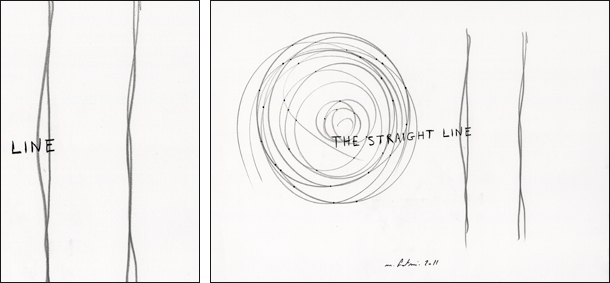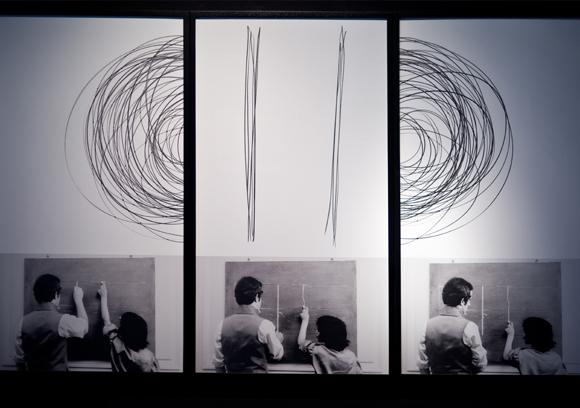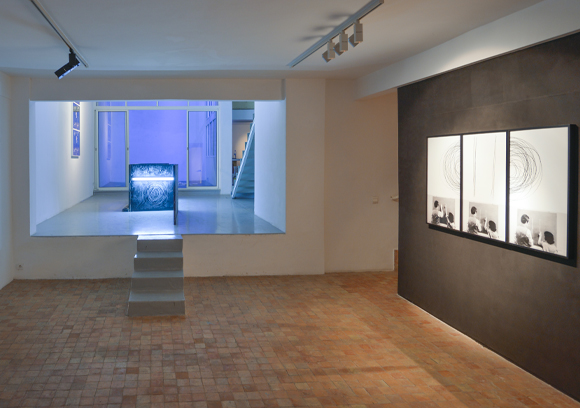| |
|
|
08.
| The Beautiful Language - The Straight Line 01 |
| |


2011, pen and pencil on paper, 29,8 x 42 cm.
Exhibition view from Constructing Illusion, Analix Forever, 2015, Geneva.
Courtesy of the artist.
'' By introducing thought-provoking statements to these images, mounir fatmi brings the original story to bear on contemporary society, bringing into focus the thin line between brutality and civilisation. ''
Caroline Rossiter

The Beautiful Language
Exhibition view from La Ligne Droite, Galerie Fatma Jellal, 2013, Casablanca.
Courtesy of the artist.

The Beautiful Language
Exhibition view from La Ligne Droite, Galerie Fatma Jellal, 2013, Casablanca.
Courtesy of the artist.
|
|
|
|
|
| This work was part of 11ème Biennale de Lyon - Une terrible beauté est né, Lyon, 2011.
« The Beautiful language » est une série de dessins initiée en 2015, inspirée du film « L'Enfant sauvage » (1970). Le film du réalisateur François Truffaut est une source d'inspiration et une référence qui apparaît dans de nombreuses œuvres de mounir fatmi, dont un projet de photographies et de vidéos également regroupées sous le titre « The Beautiful language ». Ces œuvres abordent des thèmes essentiels de l'œuvre de mounir fatmi, à savoir l'éducation et le langage. Elles explorent le fonctionnement des processus éducatifs, en relation avec l'histoire de la colonisation et de son rapport à l'altérité. Elles évoquent notamment le mythe du « bon sauvage » apparu au 18e siècle, et dont l'origine remonte au 16e siècle avec les voyages des premiers grands explorateurs européens vers les autres continents. Le fil graphique de ces œuvres se prolonge et traverse les projets de dessins ultérieurs « The Savage mind » ou encore « L'Île des racines" qui évoquent la question du voyage, de ses difficultés et parfois de ses impossibilités, et s'inspire notamment des écrits de Claude Lévi Strauss sur sa propre expérience du déplacement et de l'exil.
Les dessins déroulent une série de spirales se superposant et dont les nombreux points d'intersection sont figurés en rouge. Certaines spirales sont surmontées d'une construction géométrique qui tente d'en suivre les inflexions et les contours. D'autres sont mises en regard de lignes droites. Ce dernier motif renvoie à une scène du film de Truffaut au cours de laquelle le professeur tente d'enseigner la ligne droite à l'enfant, alors que celui s'obstine à tracer des spirales. Le motif circulaire est récurrent dans les expérimentations géométriques de mounir fatmi. Sa courbe fait le lien entre ses nombreuses sources d'inspirations scientifiques, artistiques ou philosophiques, qui vont du théorème de Descartes sur les cercles tangents aux techniques de dripping de Jackson Pollock, en passant par la calligraphie arabe et les travaux linguistiques de Wittgenstein.
Si les œuvres de mounir fatmi inspirées de « L'Enfant sauvage » ont pour préoccupation l'éducation, ses dessins, semblent en revanche s'en détourner, délaisser ce thème pour un temps, afin de s'intéresser à une part non éduquée et sauvage en soi. Comme avec « Civilisation », ready-made de mounir fatmi qui met en scène un livre clos et une paire de chaussure au propriétaire absent, les dessins semblent quitter la société des hommes pour suivre la piste de la sauvage enfance intérieure, et tenter de renouer avec elle par un jeu de fils et de liens. Leur parcours sinueux ne procède pas par rejet des éléments de civilisation, mais plutôt par l'appropriation d'une forme libre qui invite à la méditation et qui fait le lien avec un territoire intérieur. « The Beautiful language » est une exploration structurelle et une revalorisation du griffonnage, comme une voie royale et rêvée vers nos émotions et désirs informulés ou inconscients.
Studio Fatmi, Aout 2017.
|
|
« The Beautiful language » is a series of drawings initiated in 2015 and inspired by the movie « The Wild Child" (1970). This film by François Truffaut is a source of inspiration and a reference that appears in many of mounir fatmi’s creations, among which a series of photographs and videos also gathered under the title « The Beautiful Language ». These works address essential themes in mounir fatmi’s work: education and language. They explore the functioning of educational processes and put them in relation with the history of colonization and its approach to alterity. They evoke in particular the myth of the « noble savage » that appeared in the 18th century, though its origins go back to the 16th century with the first voyages of the great European explorers on other continents. The common thread between these works is extended to posterior drawing projects such as « The Savage Mind » and « The Island of the Roots » that touch upon the question of travel, its difficulty and sometimes impossibility, and takes inspiration from Claude Lévi-Strauss’ writings on his own experience of displacement and exile.
The drawings feature a series of superimposed spirals, with their numerous points of intersection appearing in red. Certain spirals are crowned with a geometric construction that tries to follow their inflections and outline. Others are placed across from straight lines. This particular motif references a scene of Truffaut’s movie in which the professor tries to teach the child to draw a straight line, as the child continues to draw spirals. The circular motif is recurrent in mounir fatmi’s geometric experimentations. Its curves connect his numerous scientific, artistic and philosophical sources of inspiration that range from Descartes’ theorem on tangent circles to Jackson Pollock’s dripping techniques, Arab calligraphy, and Wittgenstein’s research on linguistics.
mounir fatmi’s works inspired by « The Wild Child » touch upon education, but his drawings seem to veer from that subject, temporarily setting it aside in order to look into a non-educated and savage part of our inner selves. As with « Civilization », a ready-made by mounir fatmi featuring a closed book and an ownerless pair shoes, the drawings seem to leave the human society behind and to follow the path of our wild interior childhood, trying to reconnect with it through a set of lines and ties. Their sinuous outline doesn’t imply the rejection of the elements of civilization, rather the appropriation of a free form that encourages meditation and creates a connection with an interior territory. « The Beautiful Language » is a structural exploration and a rehabilitation of scribbling as the best means of access to our unspoken or unconscious emotions and desires.
Studio Fatmi, August 2017. |
|
|
|